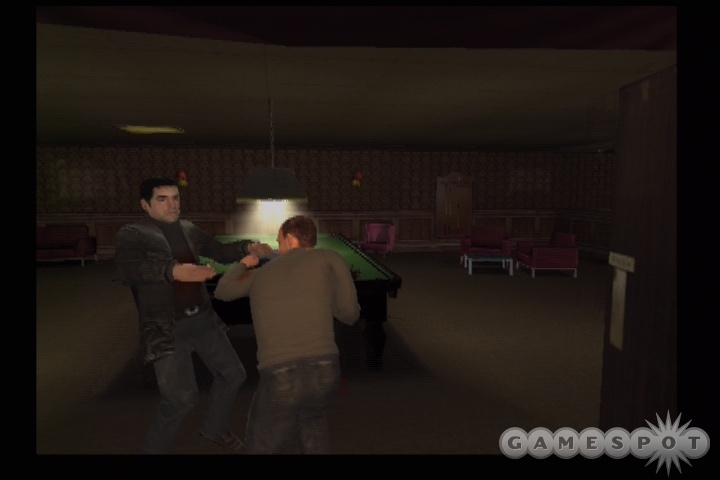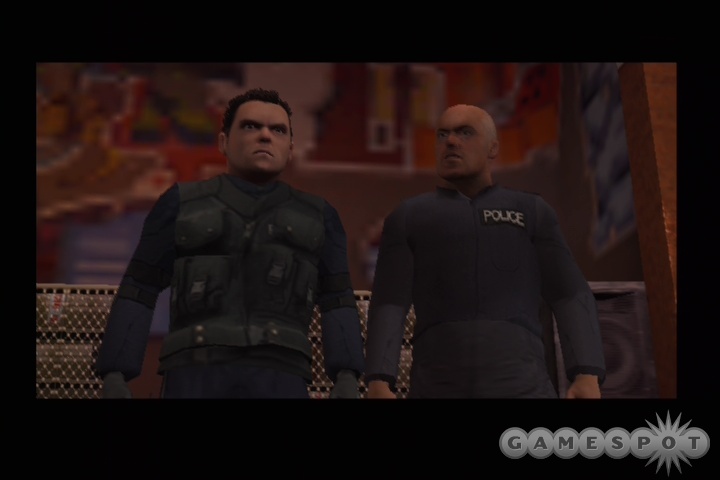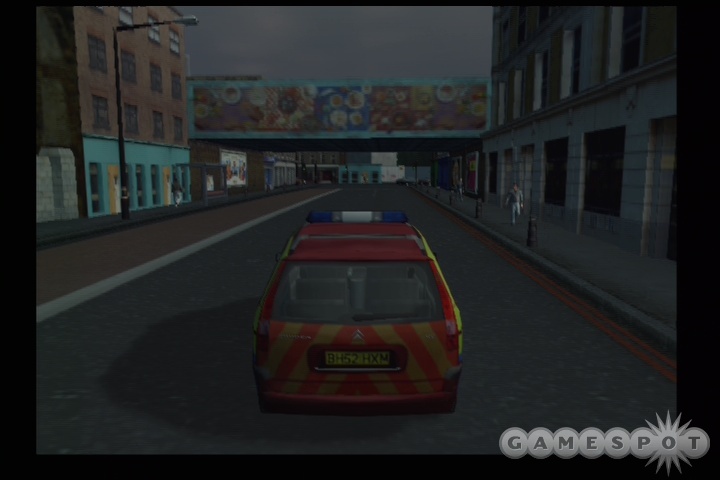In the two years that have passed since Sony released The Getaway--the company's first-party crime-drama action game that appeared on store shelves in 2003 in a rather unpolished state--many similarly "cinematic" action games have followed. And, unlike The Getaway, some of them have managed to get the concept right. So, it is with more than a little confusion that we find ourselves with The Getaway: Black Monday, a game so utterly devoted to the same flawed concepts as its predecessor that it might as well be the same game with a new story. Sure, SCEE Studio London and Team SoHo have fixed some of the superficial issues with the first game, but there are still a number of silly holdover problems in the sequel, as well as a bevy of new issues on top of everything else.

Interestingly enough, Black Monday, despite being billed as a proper sequel to the original game, actually has nothing to do with The Getaway from a storyline perspective. There are three main players in this story, each of whom has his or her own playable section and unique plot twists. You start out the game as a cop by the name of Ben Mitchell. Sergeant Mitchell is a fairly morose fellow who, as we are shown in the opening cutscene, is suspended from the police force after shooting a young perp in the back. Upon his return from suspension two years later, Mitchell is met with little more than trepidation and vitriol from his former police brethren. Later in the game, you take on the role of Eddie O'Connor, a boxer who now works as hired muscle and, when we meet him, a bank robber. Eddie is similarly rough-and-ready, though he's obviously on the other side of the law. Finally, you'll also find yourself playing as a young girl (and crook) named Sam, who ties into Eddie's sections of the story quite heavily.
The overlying story of the game isn't the easiest thing in the world to decipher. You start out as Mitchell, busting up a group of Latvian mobsters in the London underworld, and investigating the kidnapping of a prominent reporter. Once you've gotten into his story, the game abruptly shifts its focus to Eddie, who is evidently involved in some sort of major heist with a crew of misfits from his local boxing gym. Sam, the young girl, is a part of this crew, which is how she eventually enters the picture. Explaining where all this goes and how it all ties together would perhaps be delving a bit too deep into the realm of spoilers, though even if we wanted to lay out the whole plot for you, we probably couldn't. While the stories of the main characters are fairly straightforward, what exactly is going on in the background with all the Latvian gang members and heists never really becomes clear.
Part of this is because Black Monday, like its predecessor, is filled to the brim with nearly impenetrable British dialogue, including all kinds of cursing, region-specific slang, and accents you couldn't cut through with a burning knife. This isn't a bad thing by any means--in fact, it lends a certain amount of authenticity to the proceedings. All the characters are brilliantly voiced by the actors, and all the dialogue is completely believable. The problem is that the narrative doesn't ever find a way to give you a clear picture of the whole story. Some of this is obfuscation for the sake of drama, but other times it seems like the script skips over key pieces of info, or just buries them too deeply underneath all the slang and cursing to ever make sense to anyone who isn't from the East End.
While the story has its issues, the gameplay is where Black Monday truly falls apart. All three characters have distinct styles of gameplay, though none of the three mesh together in any particularly cohesive fashion. Mitchell's sections of the game play very much like a conventional shooter, but with a limited array of weapons. The one unique thing Mitchell can do is arrest the crooks he comes across. The silly thing about this, though, is that you can pretty much just run up to a guy and arrest him with a single button press. The bad guy puts up no fight, and other crooks will actually stop shooting while you're doing this, giving you a nice respite from oncoming fire. Awfully nice of them, eh?

Mitchell's sections of the game aren't very exciting, and his character is mostly unlikable. Fortunately, things pick up a bit once you shift over to Eddie's story. Though Eddie and Mitchell play similarly, Eddie is given more abilities, and he's actually a more sympathetic character than his cop counterpart. Eddie tends to pick up more weapons, ranging from various types of firearms to blunt objects like bats. Also, since Eddie is a boxer, he's not above getting into fisticuffs with any thug who gets in his way. Unfortunately, there isn't much variety in the combat, and Eddie's attacks simply boil down to throwing the same couple of punches over and over again. Thankfully, the gun-combat portions of Eddie's story are mostly pretty good, as the game tends to throw a lot of enemies at you, and even lets Eddie dual-wield certain guns, making for some very cool action sequences.
However, there is one gigantic fault in Eddie's story, and it lies in the sections that feature Sam as the playable character. Sam herself is inoffensive, but her missions are all horrible. She has no attacks whatsoever, so all her missions involve pure, unadulterated stealth of the most rudimentary and periodically broken kind. Pressing the circle button will send Sam into a "stealth mode" that uses one of the most ridiculous sneaking animations ever. It's downright cartoonish, actually. Anyway, once you're in stealth mode, you'll be undetectable to any enemies you encounter, so long as you don't get in their line of sight. This is interesting because enemies during these missions rarely ever move. There are no real patrol paths, so you can just crawl up right behind an enemy and he'll never notice. But if he catches even a glimpse of you from 100 feet away, you're toast, because then every single enemy in the building will come after you.
When you're able to avoid detection, the stealth portions of the game are merely boring, since there are no stealth attacks, or anything else to make these missions even remotely fun. And, when you are detected, you'll have to choose between an immediate death or a cheap exploitation of the brain-dead enemy AI. Basically, hiding behind certain objects like desks and barriers will suddenly cause you to be invisible, even if it's blatantly obvious where you are, and eventually your pursuers will just scamper off--that is, unless they decide to glitch out, getting stuck in some random animation or mindlessly firing in your direction, even though they're unable to hit you. There are also some non-guard characters you'll have to sneak past who will run away screaming like a little girl if they even get a whiff of you, which is just dumb, since you're this petite little 19-year-old young woman with no weapons at all, yet they're running like you're some kind of armed terrorist. To make matters worse, sometimes it won't be apparent what exactly it is you're supposed to do to sneak past these easily frightened people. It's unfortunate that these missions are even in the game, as they really cause the otherwise decent Eddie storyline to hit a brick wall.

With all that said, there are a few things in Black Monday that are improved, compared with the last game. Namely, the driving portions of the game are far less frustrating, thanks to a sped-up traffic flow that no longer prevents you from completing missions simply because you can't get past the onslaught of AI-controlled traffic. Also, cars can take a lot more damage than before. There is also a map in the game now, though it can be accessed only via the pause menu, and, honestly, you're unlikely to ever need it, as the weird but effective turn-signal direction method the last game used is back again. However, it bears mention that there's also less driving to do in this game compared with the original, so you probably won't notice these fixes quite as much.
As far as any real changes to the on-foot missions go, the only one of any real note is the fact that there are health packs scattered about some of the missions. You'll hardly ever find them useful, though, as you can still simply lean your character against a wall to regain health. And, incidentally, it's still bizarre to see your character leaning against a wall after sustaining multiple gun wounds, and then suddenly going right back to normal, with all the blood on his or her shirt disappearing into nothingness.
Black Monday is altogether a less frustrating game than its predecessor, but that also makes it a much shorter one. You can probably blow through the game's whole story in about nine hours, though there are two different endings, depending on a "moral choice" you make at one point in the game. Once you're done with the main game, there are some bonus sections to check out, including a race mode, a taxi-driving mode, a chase mode, and a free-roaming mode. All these are exactly what they sound like, and none of them are good for more than a quick, meaningless distraction, as the races and chases aren't really that exciting, and the taxi-driving mode is just kind of boring.
The free-roaming mode is probably the most appealing of all, simply because the main game never really invites you to explore the huge, accurately rendered model of the city of London that has been created for the game. It's basically the same city model that was used in the last game, but with some new locations and roads. If you're a Londoner or just a geography buff, it's kind of neat to see the city laid out in such a fashion, but apart from that, there's not really a lot to look at, since the textures on the buildings and landmarks are actually kind of flat and ugly, and there's not a lot of foot traffic or activity in the city as you play.
The most interesting aspects of the game's visuals, in fact, are its cutscenes. The game's story is told through nearly an hour's worth of very well-directed cutscenes that, were it not for the whole CG thing, could have just as easily come from a British crime film. Sadly, the quality of the graphics actually brings the scenes down a peg, as the character models aren't very detailed. There obviously was a fair amount of effort put into making the facial animations and mouth movements more realistic than in the first game, but the models are still pretty weak by today's standards, and the background scenery isn't any better. There are also some frame rate issues, physics glitches, and other problems that pop up from time to time, ultimately giving the game an archaic look.

As mentioned before, the audio is excellent, thanks largely to the dialogue and voice acting. These elements are so well done that, at times, you won't even care about the plot holes or the gratuity of the swearing. The music in the game is also quite good, consisting of a lot of electronic tracks from UK trip-hop label Ninja Tune, as well as a few orchestral tunes. There are times when these tracks seem a little too sparse, but some of them are also very good, and fit with the action nicely. The same goes for the sound effects, which all work quite well in the context of the game. Throw in some great gunshot noises, plenty of screaming bad guys, and some solid ambient effects, and you have pretty much everything you could ask for. That is, apart from a better overall game.
Like its predecessor, The Getaway: Black Monday is a "love it or hate it" kind of game, though it definitely leans a little more toward the "hate it" side of the scale. The Getaway got away with a lot of what it did mainly because it tried to do something fairly original, whereas with the sequel, there aren't many new elements, and what is new isn't exceptionally meaningful in the grand scheme of the game. Black Monday should be commended for crafting another unique crime story with plenty of memorable, well-acted characters, but unfortunately it fails to create gameplay of equal caliber. In the end, there are just too many design flaws and annoying little glitches in Black Monday to make it a recommendable play.